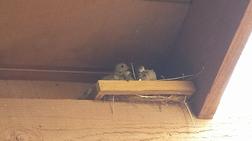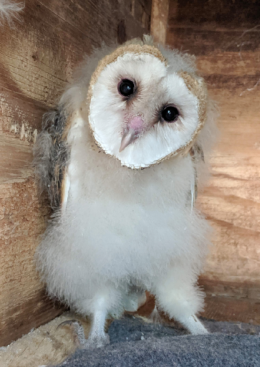I found baby bird, what do I do?
It’s a common misconception that nests are a safe place for baby birds. They are not safe. As soon as the baby has most of its feathers and starts to use its wings, it will leave the nest. It’s times like this, good intentioned people, scoop up the baby and bring it to us.
If you see a baby on the ground, observe it for the following:
Does it have most of its feathers? Is it fluttering? Do you see an adult caring for it? If yes, leave the baby there. The parents are taking care of it the way nature intended.
If the baby does not have many feathers, or just has fluff, cannot walk, or its eyes aren’t open, its too young to be out of the nest. Try and renest it. See link below for instructions.
Contact the center if you are unsure of the situation and we’ll be happy to advise.
Do I feed or give water to the animal I rescued?
Giving a potentially injured animal food or water can be hazardous to the rehabilitation progress. If at all possible, transport the animal to our center immediately. If not, call TWC at 520 290 9453 for temporary care instructions.
I found a baby bunny. Is it abandoned?
Did you know rabbit mothers leave their young for most of the day?
Cottontail rabbit mothers make small ground nests. Coming back twice a day to feed their young, many people mistake this for abandoned babies.
If you see a nest of bunnies and no mother, use the flour method to determine if the mother is returning or not. Create a circle of flour around the nest. If the mother comes back, she’ll disturb the circle, or you’ll see footprints. If the nest is disturbed, the babies are being taken care of. Leave them as is.
When the babies’ eyes and ears open, they will start exploring their world. At this age, their defense has not evolved into running. They sit still and wait out the predator. If you find a baby like this, it’s not injured, just waiting out a potential predator.
Wildlife being harassed or harmed. Who should I report it to?
The majority of all wildlife are protected by law from human harassment or harm. If you see this, report it to AZ Game and Fish poaching/illegal wildlife activity contact: 520-628-5376.
ALL RAPTORS ARE FEDERALLY PROTECTED! Raptors include eagles, falcons, kestrels, true hawks, harriers, kites, osprey, owls, and vultures. Within city limits, call both police and AZ Game and Fish.
If a bird or other animal is injured contact our center.
There’s a bird building a nest over my carport. Can I take it down?

Removing a bird nest or nestlings may be illegal due to most species being federally protected by the Migratory Bird Treaty Act.
In a few weeks the babies will be gone. After this happens, removing the nest is legal.
To mitigate the chances of birds returning to nest, use harmless deterrents such as large bird silhouettes, streamers, or blocking access with non-lethal materials.
Can you remove a nuisance animal for me?
Tucson is a unique environment where its native wildlife has adapted its home into our neighborhoods. Sometimes these animals that call the same space we live in home can turn into nuisance animals.
We are unable to help in these situations due to being a wildlife rehabilitation center. Our licensing and permitting only allow us to take in injured animals.
There are local companies that will remove these animals. We urge you to research these companies and choose one that will humanely trap the animal and release it safely.
I’m worried that a coyote or bobcat is going to take my pets.
In an areas such as Tucson, domestic pets will encounter wild bobcats and coyotes.
In general, bobcats tend to leave domestic pets alone unless threatened or cornered.
Coyotes are opportunistic and are able to prey on domestic dogs or cats. Coyotes are agile, quick and blend into the environment extremely well. Most witnesses of dog or cat attacks rarely saw the coyote coming.
See the information brochure for detailed aversion techniques.
I think an animal is living under my porch, garage, or house. What do I do?
Many animals end up in a garage or area of our home where its not safe for them or us. First, what kind of animal is it? Can you determine if it’s build a nest or has babies? If it has babies call our center for information.
If it’s alone, wait until it leaves and block the entrance. Or use bright lights and loud talk radio. These deterrents are harmless and the animal will move on.
In the case of skunks, use citrus, such as cut oranges. Surround the area with the oranges and they will leave. Skunks hate the smell of citrus!
I found a bat. What do I do?
Bats invoke unnecessary fear in many people. Bats are vital to our environment by eating insects and pollinating plants.
If you encounter an injured bat DO NOT HANDLE WITH BARE HANDS. Bats can carry rabies and it’s better to err on the side of caution than possibly be infected.
If the bat is injured, use a dustpan or something similar that allows a gentle scooping action. With gloved hands, scoop the bat into a box, give it air holes and close the lid. Keep it in a dark, quite place until it can be delivered to TWC.
If you or any domestic pets have been in direct contact with the bat, call TWC for instructions and information.
I saw a desert tortoise. What do I do?
Leave it alone. If it’s trying to cross a road or has in a hazardous area, guide it in the direction it was going. If you see one in a residential area or area where desert tortoises are not known, it could be an escaped or dumped captive tortoise. Call AZ Game and Fish at 520-628-5376.
We are not permitted to take desert tortoises.
There’s a coyote with mange, what can be done?
Coyotes are perhaps one of the most successful animals to adapt to an environment filled with humans. Coyotes are often spotted with mange and injuries.
Coyotes living close to humans are often affected by sarcoptic mange, a highly contagious skin disease caused by the microscopic mite Sarcoptes scabiei. Mange is caused by unnaturally high wildlife density, in proximity to humans, due to plentiful food and prey sources available. Mange affects many other animals as well.
Coyotes with extensive mange infections are often listless, not aggressive, and lack the appropriate fear of humans. They may become more active during the day, especially in winter, and often look for food or cover near residential areas.
Can anything be done?
Unfortunately, often by the time a rescuer arrives on the scene, the coyote is gone. Even sick, they are very hard to catch. If the coyote is mobile, the animal will be left alone, due to its resilience to living with mange and injuries.
If the coyote is immobile or allowing you to get within a few feet of it, not running away after hearing loud noises, or aggressive, call us for instructions.
Coexistence with urban wildlife – resources
Is is ok to poison animals to keep them away?
Poisons are indiscriminate killers. Once an animal is poisoned, it can travel through the ecosystem through a cascade effect. Poisoned mouse is ingested by bird, bird is eaten by bobcat, and every animal down the line is affected. Poisoning is a horrible way for an animal to die. Bleeding, seizures, pain and death are certain.
Poisons don’t just kill, they are toxic. Once an animal is poisoned, if they survive or spread the poison around, it will impair the immune systems. Poison toxicity can cause coyotes, bobcats, eagles, owls and other wildlife to be more susceptible to diseases like mange.
Alternatives to using poisons

Alternatives to using pesticides include planting “trap crops,” crops planted specifically to attract insects to deter them from other plants, removing insects manually with gloves, and excluding insects and spiders through the use of door thresholds, weather stripping and roof vents.
Alternatives to herbicides include hand pulling weeds when ground is moist, suppressing weeds with mulches free of PVCs (polyvinyl chloride), and using netted or plastic barriers under unplanted landscaping materials such as pebbles, mulch, or stone.
Instead of rodenticides, sprinkle cinnamon in areas they frequent most. Place peppermint oil-soaked cotton balls and rags throughout infested areas (you will need to re-soak frequently). Deny mice and rats access to food in your home by sealing holes and cracks that are larger than 1/4-inch wide using hardware cloth, and store all food in airtight, rodent-proof containers. Don’t leave out pet food and clean spilled birdseed.
Instead of strychnine and gas poisons, use heavy wire (or hardware cloth) to line holes for planting and to protect gardens. Sprinkle baby powder around areas rodents and rabbits frequent. Remember, desert holes made by rodents keep rain water from running off and provide moisture for plants and trees.
Glue traps – the truth
Glue traps and traps like them, cause painful, slow, deaths. Often unintended animals such as bats, birds, reptiles are caught.
Glue traps are extremely difficult to remove. DO NOT attempt to remove any animal. Call TWC 520 290 9453 immediately. Our veterinarians are trained and are the animals best hope for survival.
Preventing bird strikes
In general, if a bird can see through it, it will try to fly through it. Window strikes are one of the most common reasons birds are brought to our center.
Prevent bird strike tips:
- Use non-toxic paint or exterior tape to create patterns and images on the outside of your windows
- Use decals, glass decorations or mobiles
- Cut raptor silhouettes from black paper and stick them to the windows
- Use a window screen or leave vertical blind slats open halfway
- Plant trees and bushes outside of windows, or along the windowsill
For additional resources and excellent information, see the Tucson Audubon Society

